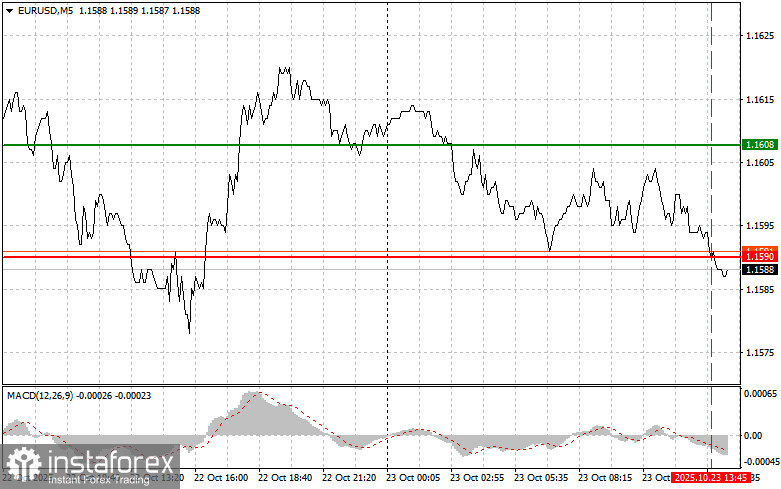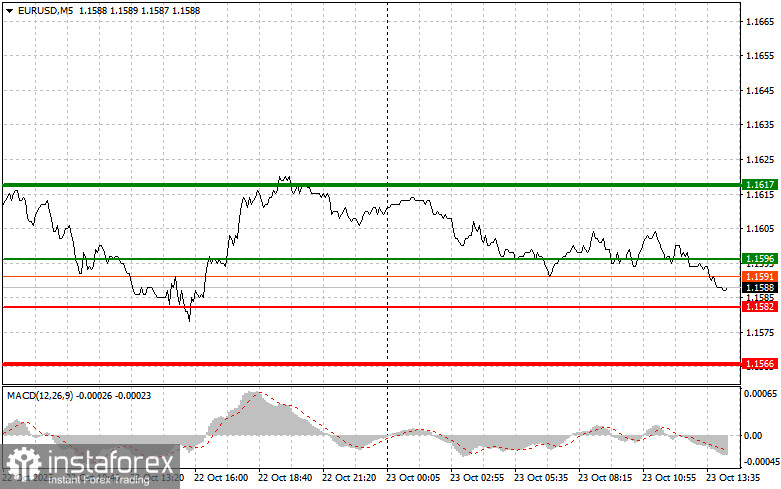Trade Analysis and Advice for Trading the European Currency
The test of the 1.1590 price occurred at a moment when the MACD indicator had already moved significantly below the zero mark, which limited the pair's downward potential. For this reason, I did not sell the euro.
The lack of significant economic indicators continues to weigh on traders, leading to a decrease in market volatility. It is clear that market participants, lacking clear macroeconomic guidance, have preferred to adopt a wait-and-see attitude, refraining from risky actions amid uncertainty.
In the second half of the day, U.S. existing home sales data will be released. However, the main focus will be on speeches by Federal Reserve representatives Michael Barr and Michelle Bowman. Market participants will try to hear firsthand a new assessment of the economic situation and, more importantly, any signals regarding further interest rate cuts. It is quite possible that Barr and Bowman will prefer not to provide clear evaluations and will avoid concrete forecasts, maintaining uncertainty about the Fed's next steps. Nevertheless, their overall tone—signs of confidence or, conversely, restraint—will affect market sentiment.
As for intraday strategy, I will rely more on scenarios #1 and #2.

Buy Signal
Scenario #1: Today, you can buy the euro around the 1.1596 level (green line on the chart) with a target of growth to 1.1617. At 1.1617, I plan to exit the market and also open a sell position in the opposite direction, aiming for a 30–35-point move from the entry point. Expect a euro rise only after dovish (soft) statements.Important! Before buying, make sure the MACD indicator is above the zero line and just starting to rise from it.
Scenario #2: I also plan to buy the euro today in case of two consecutive tests of the 1.1582 price, at the moment when the MACD indicator is in the oversold area. This will limit the pair's downward potential and lead to a market reversal upward. A rise to the opposite levels of 1.1596 and 1.1617 can be expected.
Sell Signal
Scenario #1: I plan to sell the euro after reaching the 1.1582 level (red line on the chart). The target will be the 1.1566 level, where I plan to exit the market and immediately open a buy position in the opposite direction (expecting a 20–25-point move upward). Downward pressure on the pair may increase significantly today.Important! Before selling, make sure the MACD indicator is below the zero line and just starting to decline from it.
Scenario #2: I also plan to sell the euro today in case of two consecutive tests of the 1.1596 price, when the MACD indicator is in the overbought area. This will limit the pair's upward potential and lead to a market reversal downward. A decline to the opposite levels of 1.1582 and 1.1566 can be expected.

Chart Key:
- Thin green line – entry price where the instrument can be bought;
- Thick green line – approximate price where Take Profit orders can be placed or profits can be fixed manually, as further growth above this level is unlikely;
- Thin red line – entry price where the instrument can be sold;
- Thick red line – approximate price where Take Profit orders can be placed or profits can be fixed manually, as further decline below this level is unlikely;
- MACD indicator – when entering the market, it is important to consider overbought and oversold zones.
Important Notice
Beginner Forex traders should make market entry decisions very carefully. Before the release of major fundamental reports, it is best to stay out of the market to avoid sharp price swings. If you decide to trade during news releases, always place stop orders to minimize losses. Without stop orders, you can quickly lose your entire deposit—especially if you do not use money management and trade with large volumes.
And remember: for successful trading, you must have a clear trading plan—like the one presented above. Making spontaneous trading decisions based on current market conditions is, from the outset, a losing strategy for an intraday trader.





















